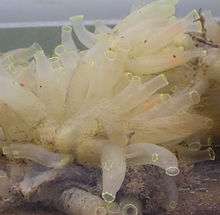Ciona
Ciona is a genus of sea squirts in the family Cionidae.
| Ciona | |
|---|---|
 | |
| Ciona intestinalis | |
| Scientific classification | |
| Kingdom: | |
| Phylum: | |
| Subphylum: | |
| Class: | |
| Order: | |
| Suborder: | |
| Family: | |
| Genus: | Ciona |
| Species | |
|
Ciona edwardsi | |
The body of Ciona is bag-like and covered by a tunic, which is a secretion of the epidermal cells. The body is attached at a permanent base located at the posterior part, and the opposite bears two openings, the buccal (oral) and atrial (cloacal) siphons. The water is drawn into the ascidian through the buccal siphon and leaves the atrium through the atrial siphon.
Species
Species in this genus include:[1]
- Ciona antarctica (Hartmeyer, 1911)
- Ciona edwardsi (Roule, 1884)
- Ciona fascicularis (Hancock, 1870)
- Ciona gefesti (Sanamyan, 1998)
- Ciona gelatinosa (Bonnevie, 1896)
- Ciona hoshinoi (Monniot C., 1991)
- Ciona imperfecta (Monniot C. & Monniot F., 1977)
- Ciona intestinalis (Linnaeus, 1767)
- Ciona longissima (Hartmeyer, 1899)
- Ciona mollis (Ritter, 1907)
- Ciona pomponiae (Monniot C. & Monniot F., 1989)
- Ciona robusta (Hoshino & Tokioka, 1967)
- Ciona roulei (Lahille, 1887)
- Ciona savignyi (Herdman, 1882)
- Ciona sheikoi (Sanamyan, 1998)
Genome projects
As of 2008, the genomes of Ciona intestinalis and Ciona savignyi have been sequenced.
Sexual reproduction
C. intestinalis is a hermaphrodite that releases sperm and eggs almost simultaneously into the surrounding seawater. C. intestinalis is self-sterile and thus has been used for studies on the mechanism of self-incompatibility.[2] C. savigny is highly self-fertile, but non-self sperm out-compete self-sperm in fertilization competition assays.[3] Mechanisms promoting non-self fertilization may have evolved to avoid inbreeding depression,[3] and to facilitate outcrossing which allows the masking of deleterious recessive mutations.[4]
References
- "WoRMS - World Register of Marine Species - Ciona Fleming, 1822". www.marinespecies.org. Retrieved 2018-09-30.
- Sawada H, Morita M, Iwano M (August 2014). "Self/non-self recognition mechanisms in sexual reproduction: new insight into the self-incompatibility system shared by flowering plants and hermaphroditic animals". Biochem. Biophys. Res. Commun. 450 (3): 1142–8. doi:10.1016/j.bbrc.2014.05.099. PMID 24878524.
- Jiang D, Smith WC (October 2005). "Self- and cross-fertilization in the solitary ascidian Ciona savignyi". Biol. Bull. 209 (2): 107–12. doi:10.2307/3593128. JSTOR 3593128. PMID 16260770.
- Bernstein H, Byerly HC, Hopf FA, Michod RE (September 1985). "Genetic damage, mutation, and the evolution of sex". Science. 229 (4719): 1277–81. doi:10.1126/science.3898363. PMID 3898363.
External links
- The Tunicate Portal, an access point to the main websites and databases dealing with tunicates
- Ascidians.com, pictures of species around the world
- ANISEED, a model organism database for several ascidians species including Ciona intestinalis and Halocynthia roretzi
- JGI Ciona intestinalis v2.0, genome sequence
- View the Ciona intestinalis genome in the Ensembl genome browser .